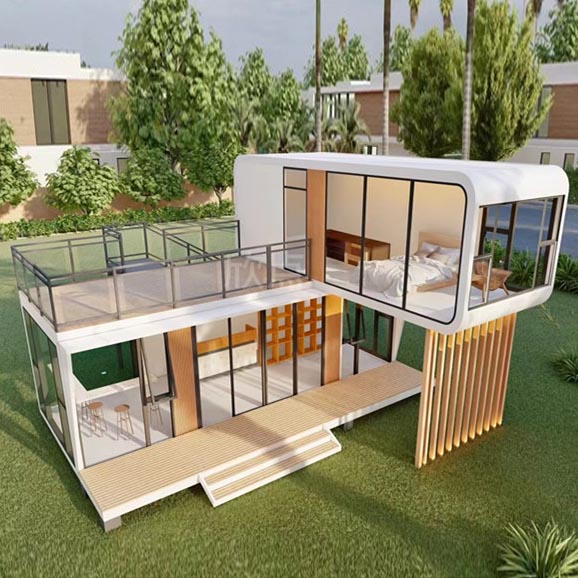How Do Residential Modular Houses Transform Modern Living?
2025-09-30
In recent years, residential modular houses have emerged as a groundbreaking solution for homeowners seeking efficiency, affordability, and sustainability.
Unlike traditional stick-built homes that are constructed entirely on-site, modular houses are manufactured in controlled factory environments. Each module, or section, is built with precision engineering and then transported to the building site for assembly. This process reduces construction time by nearly half, minimizes weather-related delays, and ensures higher quality standards due to factory oversight.
The growing demand for residential modular houses can be attributed to multiple factors: rising housing costs, increased awareness of sustainable building methods, and the pressing need for faster housing solutions in urban and suburban areas. With modern design capabilities, modular homes are no longer seen as temporary structures. Instead, they represent permanent, durable, and aesthetically appealing residences that can rival or even surpass traditional homes.
How Product Features of Residential Modular Houses Ensure Quality and Comfort
The success of modular housing depends largely on the technical parameters that ensure both comfort and long-term durability. Below is a detailed breakdown of the typical product specifications and performance standards of modern residential modular houses:
| Parameter | Specification |
|---|---|
| Structure Frame | High-strength steel or treated wood framing with anti-corrosion and seismic design |
| Wall & Roof Panels | Insulated sandwich panels with fireproof and waterproof layers |
| Flooring System | Reinforced concrete base or engineered wood flooring for durability |
| Windows & Doors | Double-glazed tempered glass with thermal break aluminum frames |
| Insulation Standard | R-values compliant with international energy codes (R-19 to R-30 depending on region) |
| Electrical System | Pre-wired circuits, compliant with UL/CE standards, ready for smart-home upgrades |
| Plumbing System | PEX or copper piping with water-saving fixtures and centralized water heating |
| Exterior Finishes | Customizable cladding options: vinyl, fiber cement, brick veneer, or composite panels |
| Interior Finishes | Drywall, acoustic ceiling panels, vinyl/wood flooring, fully customizable interiors |
| Average Lifespan | 50–70 years with proper maintenance |
| Installation Time | 4–12 weeks depending on size and design complexity |
| Energy Efficiency | Designed for net-zero capability with optional solar integration |
These parameters are not just numbers on a sheet; they directly affect daily living comfort. For example, advanced insulation combined with double-glazed windows significantly reduces energy bills while maintaining a stable indoor temperature year-round. Fireproof wall systems ensure safety, while seismic-resistant structures make modular houses suitable for regions prone to earthquakes.
The construction method also allows modules to be built under strict quality control. Factory settings eliminate environmental exposure during construction, reducing moisture issues, structural weaknesses, and unexpected cost overruns. As a result, homeowners enjoy both peace of mind and superior craftsmanship.
Another defining factor is flexibility. Modular homes are not restricted to one-size-fits-all layouts. Instead, they offer floor plan customization, allowing for single-story bungalows, two-story family houses, or even multi-unit developments. By integrating modern design trends such as open kitchens, large glass facades, and energy-efficient roofing, modular homes seamlessly adapt to contemporary lifestyles.
How Residential Modular Houses Deliver Cost Efficiency and Sustainability
One of the most pressing challenges in housing today is balancing affordability with quality. Residential modular houses provide a compelling answer by optimizing cost efficiency without compromising performance. But how do they achieve this balance?
First, modular construction streamlines the building timeline. With factory-built modules, on-site preparation and module fabrication occur simultaneously. This dual process reduces total construction time by up to 50%, resulting in significant savings on labor and financing. Shorter construction schedules also mean quicker move-ins, which is particularly valuable for families and real estate developers.
Second, material efficiency plays a vital role. Factories produce modules using standardized components, which minimizes waste by up to 80% compared with traditional construction sites. Leftover materials can be recycled within the factory environment, promoting a circular economy.
Third, energy savings over the lifespan of the home make modular houses more economical. High-grade insulation, airtight construction, and compatibility with renewable energy systems ensure reduced energy bills. Many modular homes are designed to meet LEED or Passive House certification standards, which further boosts sustainability credentials.
Environmental responsibility is not just a trend; it is a necessity in modern construction. Modular houses require fewer heavy vehicle trips to the site, which lowers carbon emissions. Additionally, factory production reduces disturbances to the surrounding environment, protecting ecosystems and minimizing noise and dust pollution.
From a financial perspective, homeowners often benefit from predictable costs. Since modules are manufactured in controlled settings, price fluctuations caused by weather delays, theft, or on-site inefficiencies are minimized. Developers and private buyers alike gain confidence knowing that the quoted budget is far more likely to match the final cost.
The result is a model of housing that is both economically viable and environmentally responsible. With increasing government incentives for green construction, modular housing stands as a strong contender for future urban planning strategies.
How to Choose and Invest in Residential Modular Houses
For potential buyers, the decision to invest in a residential modular house requires careful consideration. How can one select the right design, features, and provider to maximize long-term value? The answer lies in evaluating both personal needs and professional expertise.
Factors to Consider Before Choosing
-
Location & Climate – Ensure the house specifications align with regional weather conditions (e.g., insulation for cold climates, ventilation for hot regions).
-
Size & Layout – Assess current and future family needs to select an adaptable floor plan.
-
Energy Efficiency – Look for homes with certified insulation, efficient HVAC systems, and renewable integration options.
-
Customization Options – Determine how much flexibility is available in interior finishes, facades, and smart-home upgrades.
-
Compliance & Safety – Verify that the home meets local building codes and international safety standards.
-
Provider Reputation – Research manufacturer track records, customer reviews, and warranty policies.
Common FAQs
Q1: How long does it take to build and install a residential modular house?
A residential modular house typically takes between 4 and 12 weeks for completion, depending on the size and complexity of the design. Unlike traditional construction, where weather delays and material shortages are common, modular houses benefit from parallel processes—site preparation and factory fabrication occur simultaneously. This means families can move in faster, reducing both rental expenses during the transition and overall financing costs.
Q2: How durable are modular houses compared to traditional homes?
Modular houses are engineered to meet or exceed local building codes. The use of steel or treated wood framing, fireproof wall systems, and seismic-resistant structures ensures durability. With proper maintenance, these houses have a lifespan of 50–70 years, comparable to or even exceeding many traditional homes. Moreover, controlled factory construction eliminates structural inconsistencies often found in on-site builds, providing superior long-term reliability.
Why Cymdin Is a Trusted Partner
When navigating the world of residential modular houses, selecting a reliable brand is crucial. Cymdin has earned a strong reputation for delivering homes that embody durability, modern aesthetics, and eco-conscious design. With expertise in modular technology and a commitment to customer satisfaction, Cymdin ensures every project aligns with international standards while adapting to local needs.
Whether you are an individual homeowner seeking a cost-effective living solution or a developer planning large-scale housing, Cymdin provides tailored modular house solutions that blend efficiency, comfort, and sustainability. To explore your options and begin the journey toward your ideal modular home, contact us today for expert guidance and personalized consultation.



